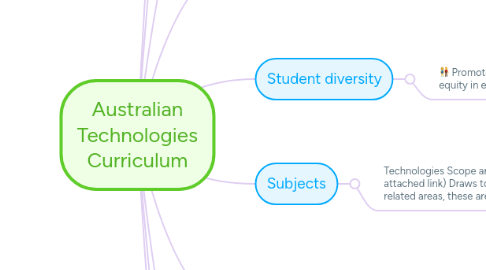
1. Key concepts
1.1. Australia needs future generations to have the ability to make decisions regarding the development and use of technology.
1.1.1. Over Arching idea = Creating preferred Futures
2. Key ideas of the Technologies learning area
2.1. Creating preferred futures
2.2. Project management
2.3. Thinking in Technologies
2.4. Design thinking
2.5. Computational thinking
2.6. Information and communication technology in the Australian Curriculum
2.7. Safety
2.8. Animal ethics
3. General capabilities
3.1. Teachers are encouraged to incorporate other learning areas when the teaching and learning program of Technologies is implemented. The general capabilities are;
3.1.1. Literacy
3.1.2. Numeracy
3.1.3. Information and communication technology (ICT) capability
3.1.4. Critical and creative thinking
3.1.5. Personal and social capability
4. Cross-curriculum priorities
4.1. The cross-curriculum priorities address the contemporary issues that students face in a globalised world.These include the following areas which should be incorporated in to the Technologies teaching and learning program where appropriate.
4.1.1. Aboriginal and Torres Strait Islander histories and cultures
4.1.2. Asia and Australia's engagement with Asia
4.1.3. Sustainability
5. Student diversity
5.1. Promotes excellence and equity in education.
5.1.1. Students with disability
5.1.2. English as an additional language or dialect
5.1.3. Gifted and talented students
6. Subjects
6.1. Technologies Scope and Sequence (see attached link) Draws together two distict but related areas, these are;
6.1.1. Design and techologies
6.1.2. Digital Technologies
7. Year levels
7.1. The content descriptors / elaborations and achievement standards are written in bands. These comprise of the following;
7.1.1. Foundation to year 2
7.1.2. Years 3 and 4
7.1.3. Years 5 and 6
7.1.4. Years 7 and 8 (not relevant for Primary)
7.1.5. Year 9 and 10 (not relevant for Primary)
8. The curriculum structure
8.1. Strands
8.1.1. Both subjects ( Design and Technology & Digital Technologies) in the Technologies learning area are presented through two strands that are complimentary of each other. For further information please see the table in the link attached to each.
8.1.1.1. Knowledge and Understanding
8.1.1.2. Process and Production Skills
8.2. Content descriptors
8.2.1. Content descriptors are specific indicators or outcomes which identify the learning that should occur. They are classified under strands and sub-strands and are provided for each year level. The relevant (WA) curriculum link is attached.
8.2.1.1. Under each content descriptor there are various elaborations provided to assist the interpretation/guide teachers when focusing on a content or part of a content descriptor.
8.3. Achievment Standards
8.3.1. The Achievement Standards are still being Developed in WA. These will be developed using (assessment) work sample evidence to ‘set’ standards by use of comparisons.
9. Technologies glossary
9.1. For further clarification of key terms used in this learning area, refer the glossary at this link;
10. Curriculum aims and objectives
10.1. The Technologies curriculum aims to develop the knowledge, understandings and skills to ensure that, individually and collaboratively, students are able to achieve the following objectives:
10.1.1. investigate, design, plan, manage, create and evaluate solution
10.1.2. are creative, innovative and enterprising when using traditional, contemporary and emerging technologies, and understand how technologies have developed over time
10.1.3. make informed and ethical decisions about the role, impact and use of technologies in the economy, environment and society for a sustainable future
10.1.4. engage confidently with and responsibly select and manipulate appropriate technologies − materials, data, systems, components, tools and equipment.
10.1.5. critique, analyse and evaluate problems, needs or opportunities to identify and create solutions.
